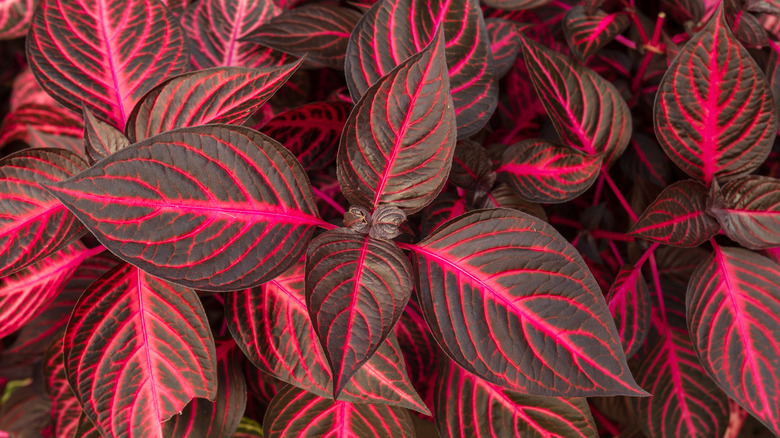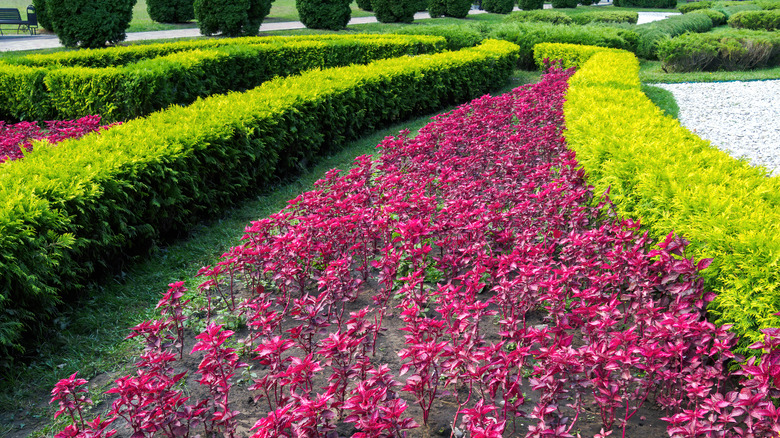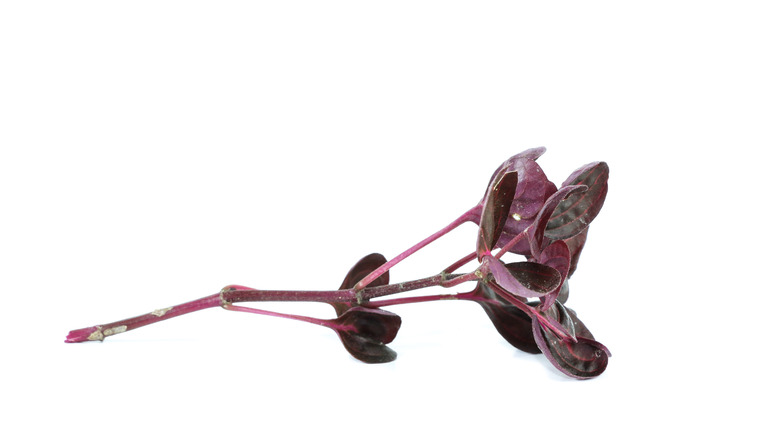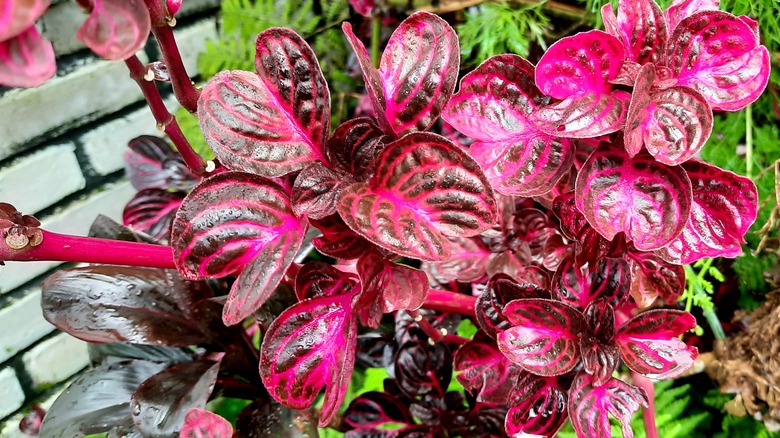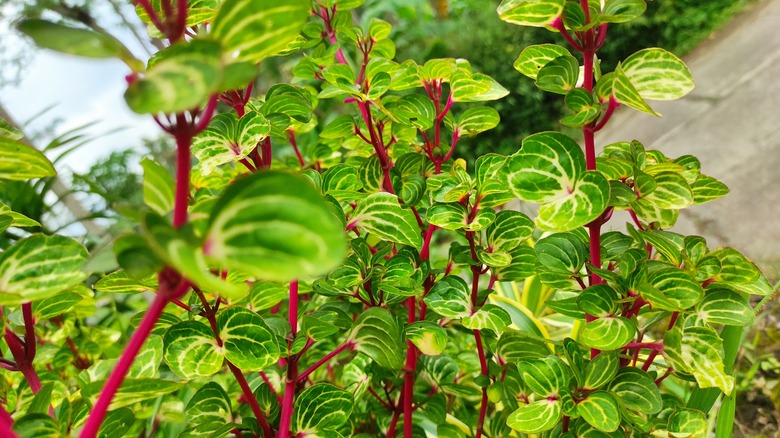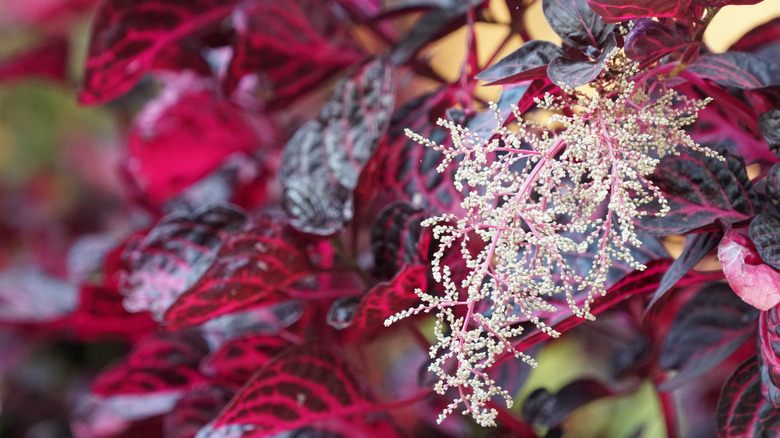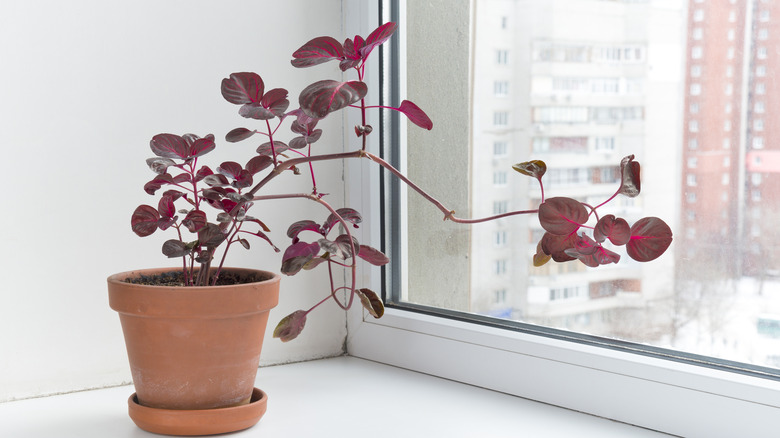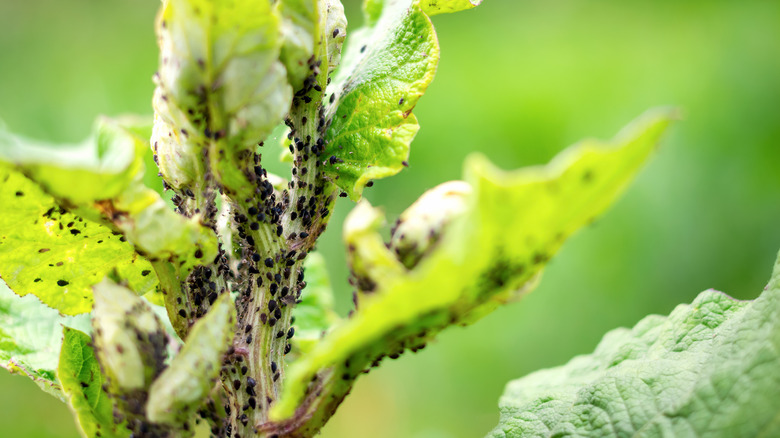Bloodleaf Plant: Everything You Should Know Before Planting
Bloodleaf, beef plant, beefsteak, chicken gizzard ... now here's a plant with some funky nicknames. Scientifically known as iresine herbstii, this deep crimson shiny-leafed plant is native to Central and South America, where it is especially common in Brazil. The bloodleaf plant is classified as a tender perennial. This means it can continue to grow year-round for many years, so long as it lives in a warm climate zone. In colder areas the bloodleaf plant can be grown outdoors as an annual and left to die off at the first frost towards the end of the season. Otherwise it will need to be brought inside before the temperature drops. According to The Spruce, the lowest tolerable temperature is 50 degrees Fahrenheit, but it would behoove any gardener to keep it higher than that.
Bud pinching is common with these plants because, while a healthy bloodleaf does flower, the blooms are so insignificant they could never hold a candle to those show stopping leaves. Be sure to envision the tropics when finding the best location for your bloodleaf plant whether in your home or out in the yard. These sun lovers crave a lot of light and need plenty of moisture too.
How to use bloodleaf plant in a garden
If you're trying to dazzle up a drab landscape, nothing brings a better shock of bold color than the garnet leaf and stem combination of iresine herbstii. This is a plant that will happily put on a solo show when planted alone in a hanging basket. For an even more dramatic effect, create a contrast of deep red against bright green foliage by planting a wave of bloodleaf plants down the length of a hedgerow. Iresine herbstii makes an excellent choice for the edging around a flower bed as well. One more suggestion from the growers at Outside Pride is to use them for a ground cover. As they grow low and dense, they'll help keep pesky weeds from popping up. Flowers in complementary colors spaced throughout the ground cover will finish off a pleasing look.
When it comes to location, a bloodleaf plant will survive in partial shade but not without a price. Low light conditions will cause its leaves to become lackluster and for their red hues to fade into a dark, less impressive purple. Full sun exposure is necessary for the brightest and most saturated coloring.
How to grow a bloodleaf plant
Propagating bloodleaf plants could not be any easier than it is. A stem cutting left to root in a jar of water is really all it takes to double your crop. Not all plants can be started by this method, but the soft stems of the bloodleaf are just right for the task. The guide to starting new plants from stem cuttings by Better Homes & Gardens suggests taking a cutting that is 3 to 6 inches long. With sharp, sanitized cutting shears or scissors, cut just beneath a node. This is a slightly wider part of the stem from where leaves grow. Remove the bottom leaves so that only a few at the top remain. This will make it so it's only the stem that sits in the water. Refresh the water after a couple of days and you should see new root growth within a week.
If you choose to try your hand at growing a stem cutting in soil, use a light dusting of rooting hormone on the cut end. Once the cutting is planted, enclose the entire pot in a sealed clear plastic bag. This will create an environment with high humidity perfect for a baby bloodleaf.
How to care for a bloodleaf plant
Iresine herbstii bloodleaf plants require regular watering and prefer soil that remains damp. Standing water is never advised, of course, but do make sure to give these plants a thorough daily drink. As already noted, sun exposure is important. Indoors, a potted bloodleaf will thrive near a south-facing window. As explained by How Stuff Works, southern exposure offers the highest level of natural light. It also allows your plants to directly take in solar energy, an important source of life, especially for a tropical native.
Bloodleaf plants should stay full and bushy, but they may need a little maintenance to do so. If your plant starts to get leggy (meaning long stems with only a few leaves at the top), that's a clear sign that it is not receiving enough light. Prune it back when necessary to maintain its shape and give it more time in direct light. For darker areas, try adding artificial grow lights for a few hours a day.
Bloodleaf plant varieties
There are thought to be around 20 to 25 varieties of bloodleaf plants, including hybrid cultivars. However, only a few are commonly sold as houseplants. Some have indentations at the rounded tops of the leaves, while others, like the IIresine herbstii 'Brilliantissima', will have more triangle-shaped leaves with pointier tips.
Exactly the same as the original in shape and size, although very different in coloring, the Iresine herbstii 'Aureoreticulata' has green leaves with yellow veins growing on red stems. Seen pictured above, it's a fun option that brings that earlier mentioned color contrast into the garden all by itself. As with the others, you can pinch the small buds as they arrive and prune back the entire plant to keep it low and full. However, as noted by the authors over at Plants To Grow, it's also nice to let this one thin out just enough show off those unusual bright pink stems.
There is also a difficult to find bloodleaf variety called Iresine herbstii 'Variegated Heart'. This remarkable cultivar blends the best of both plants, the original and the Aureoreticulata, by creating an almost heart-shaped burst of red at the center of the green leaves. The base of the vein gets a splash of pink in the process that then dissolves into the yellow.
Is the bloodleaf plant toxic?
There's nothing to worry about if you have pets or children living near an irestine herbstii. It is a completely safe and nontoxic plant that actually boasts a long list of medicinal properties. A 2011 study published in the African Journal of Traditional, Complementary and Alternative Medicines found that cultures from India to Africa to South America regularly use the leaves of the bloodleaf as an anti-inflammatory and as a wrap to heal wounds. Some scientists believe this plant has anti-cancer properties which can halt cell division and cause cancerous cells to die.
It is purported that irestine herstii has also been used for centuries up in the high altitudes of the Peruvian Andes. Healers there believe it has the power to exorcize evil spirits from the body and, therefore, include it in a variety of rituals. It's possible that bloodleaf has hallucinogenic properties to boot, since it has been used as an additive for both ayuhuasca and San Pedro concoction ceremonies.
How to repot a bloodleaf plant
Bloodleaf plants are fast growers, so repotting your indoor houseplants is a must. Once per year until it reaches maturity is the general rule of thumb. A springtime repotting routine is a good one to get into, but don't forget to check regularly for any signs of a root bound plant. A suffering plant (leaf discoloration, legginess, or one with roots sneaking out through the drainage holes at the base of its grow pot) is in need of attention. Repot with quality moisture retaining soil. Ask at your local garden center for something loamy with a high organic matter content.
Guide to Houseplants has a nifty tip to guarantee your plant will never be stuck in a pool of standing water. This trick will work provided your bloodleaf is planted in a grow pot that is then sitting inside a more decorative outer pot. First repot your plant in a grow pot that is an inch or two bigger than the original and set it aside. Now get your decorative pot ready by placing a layer of small rocks inside on the bottom. Place your grow pot on top of these. The rocks will keep the roots above the water that drains from the grow pot. And the space between will harbor humidity as that water evaporates. It's a win-win situation that your moisture loving iresine is sure to appreciate.
Common pest issues with the bloodleaf plant
In regards to iresine herbstii bloodleaf plants, the most common pests to look out for are spider mites and aphids. Sometimes these insects may be too small to see, but the evidence will be apparent in the damage they cause. What you are likely to notice is their sloppy leftovers: a sticky residue that remains on the leaves from the insects sucking the sap from them. Also, you're bound to see a peppering of tiny bite marks.
If you find yourself with an infestation problem, whether it spider mites or aphids, SFGate recommends using an insecticidal soap spray. It's important to look for pyrethrin on the ingredients label. This plant based compound is an extract that comes from the chrysanthemum flower. It basically acts as nature's first line of defense against pests. Pyrethrin causes paralysis and kills insects almost instantly without doing harm to the plant. If used outdoors, wait until bees and other beneficial insects have left the area before spraying.
